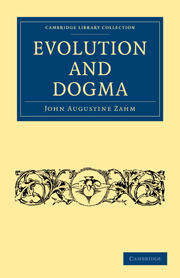Book contents
- Frontmatter
- PREFATORY NOTE
- Contents
- INTRODUCTION
- PART I EVOLUTION, PAST AND PRESENT
- CHAPTER I NATURE AND SCOPE OF EVOLUTION
- CHAPTER II EARLY EVOLUTIONARY VIEWS
- CHAPTER III FOSSILS AND GIANTS
- CHAPTER IV SPONTANEOUS GENERATION AND SCIENTIFIC DISCOVERY
- CHAPTER V FROM LORD BACON TO CHARLES DARWIN
- CHAPTER VI CONTROVERSY AND PROGRESS
- CHAPTER VII EVIDENCES OF EVOLUTION
- CHAPTER VIII OBJECTIONS AGAINST EVOLUTION
- PART II EVOLUTION AND DOGMA
- AUTHORS AND WORKS CITED IN “EVOLUTION AND DOGMA.”
- GENERAL INDEX
CHAPTER VII - EVIDENCES OF EVOLUTION
Published online by Cambridge University Press: 29 August 2010
- Frontmatter
- PREFATORY NOTE
- Contents
- INTRODUCTION
- PART I EVOLUTION, PAST AND PRESENT
- CHAPTER I NATURE AND SCOPE OF EVOLUTION
- CHAPTER II EARLY EVOLUTIONARY VIEWS
- CHAPTER III FOSSILS AND GIANTS
- CHAPTER IV SPONTANEOUS GENERATION AND SCIENTIFIC DISCOVERY
- CHAPTER V FROM LORD BACON TO CHARLES DARWIN
- CHAPTER VI CONTROVERSY AND PROGRESS
- CHAPTER VII EVIDENCES OF EVOLUTION
- CHAPTER VIII OBJECTIONS AGAINST EVOLUTION
- PART II EVOLUTION AND DOGMA
- AUTHORS AND WORKS CITED IN “EVOLUTION AND DOGMA.”
- GENERAL INDEX
Summary
Systems of Classification
BEFORE discussing the evidences of Evolution, or examining the arguments advanced in its support, it is advisable to have some idea of the different systems of classification which have obtained in various periods of the history of science, and to learn on what such systems were based. Have naturalists in all ages employed essentially the same systems of classification, or have their systems been widely different, if not contradictory? Are scientific classifications expressions of natural arrangements existing in animated nature, or are they but artificial devices for coördinating our knowledge of nature and facilitating our investigations? Have species, genera, families, orders, classes and branches, a real or an ideal existence? Are they manifestly disclosed in the plan of creation or are they but arbitrary categories hit upon by naturalists as convenient aids in arrangement and research? These are a few of the many questions which present themselves for an answer as we approach the subject of organic Evolution. Others there are also which might be discussed but we have not space for them now.
The system of classification of Aristotle, and of the naturalists of antiquity generally, was of the most primitive character. It recognized but two groups, γένος and εἷδος, genus and species. These terms, as a rule, had only a very vague meaning, and were frequently made to embrace groups of animals that we should now refer to orders and classes.
- Type
- Chapter
- Information
- Evolution and Dogma , pp. 84 - 139Publisher: Cambridge University PressPrint publication year: 2009First published in: 1896



